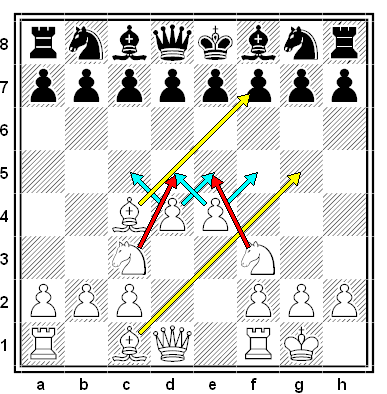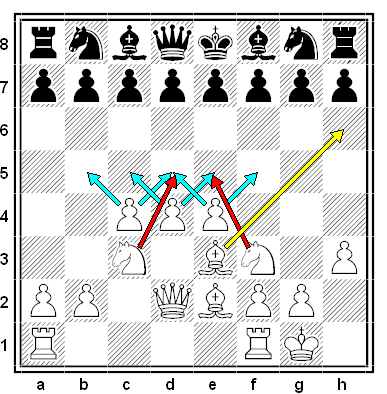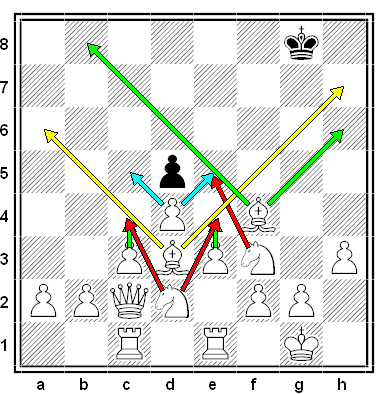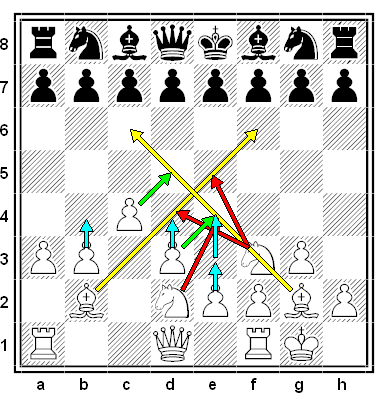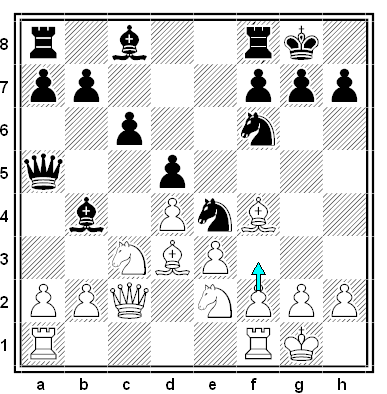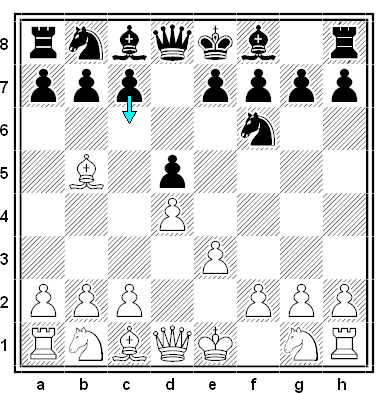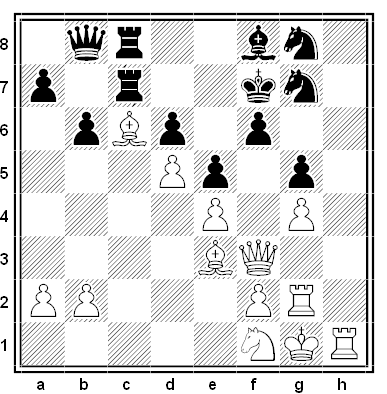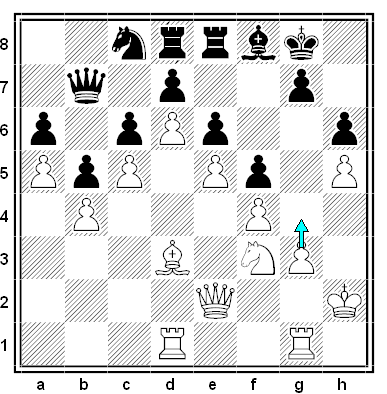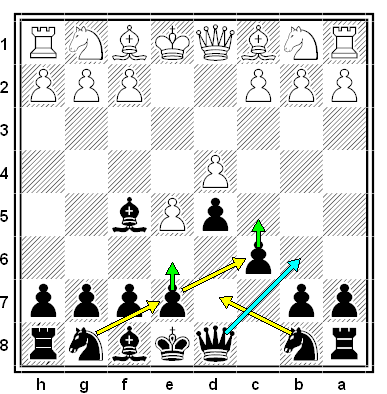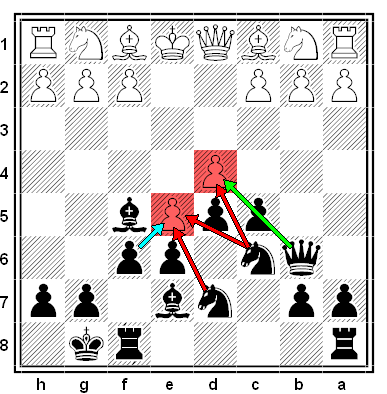The General Principles of Opening Play
{note this document is printable [7 pages]}
1. The Queen
DO NOT bring your Queen out too early. This CAN be successful as the Queen is a very strong piece - e.g. many players have successfully executed SCHOLAR'S MATE. However, IF THE OPPONENT PLAYS CORRECTLY, he/she will easily cover the threats and drive your Queen away. When you play chess you should always play AS THOUGH YOUR OPPONENT WILL PLAY THE BEST MOVE. This is a good habit to get into. Not to do so is to rely on cheap traps and tricks and you will certainly come unstuck against good players. You WILL LOSE TIME keep having to move your Queen as she is attacked. TIME is chess is moves [see no.5]. Your opponent will gain a development advantage as he/she brings out his/her pieces attacking your Queen. Your Queen may even become lost. It is nonsensical to try to fight a battle by sending out only one or two pieces to fight.
If your opponent brings out his/her Queen early BE VERY CAREFUL TO COVER THE THREATS. Then look to see how you can develop your pieces to harass the Queen and drive her back.
You MAY bring your Queen out early to execute a double threat which may well win a piece, though again, care must be taken against tactical traps.
2. Rapid Development
Try to mobilise your army quickly and to get ALL your pieces into play. The ideal is to move each minor piece once only, and to try to put your pieces on effective squares. A central pawn move {e or d pawn}, or a pawn move to fianchetto a Bishop counts as one devloping move. So in the Classical centre diagram below White has played 5 developing moves. In any opening position it is easy, therefore, to count up who is ahead in development.
Obviously if your piece is attacked (e.g. by a pawn) you WILL have to move it twice (or three times) to avoid loss of material. These rules ARE ONLY A GUIDE. - YOU MUST CHECK THE TACTICS FIRST - Is anything being attacked ? Has your opponent a threat ? If there are no direct threats then see how you can develop your pieces quickly and effectively, and try to produce a threat of your own as you do so.
3. The KING
PROTECT YOUR KING - It is amazing how even very good players can neglect the safety of their King. PRECARIOUS KING POSITION is the main cause of losing a game of chess. The normal situation would be to CASTLE and to AVOID MOVING THE PAWNS IN FRONT OF YOUR KING. Moving these pawns will open lines to your own King and may be suicidal! Castling is particularly important if central pawns have been exchanged and the position has become "open" in the centre. Then the King may be "caught with his pants down" ! You do NOT always have to castle, but be very careful with the vulnerable point f2 (f7 for Black). Occasionally the King may be safer in the centre or other moves are more urgent - but remember you are using a high risk strategy in that case and may be caught out ! Also when Queens have been exchanged the King MAY be better centralised for the ending.
4. The Centre
The centre is the 4 squares e4, d4, e5, d5, and the extended centre includes the 12 squares c3 to c6 to f6 to f3.
You should ALWAYS TRY TO CONTROL THE CENTRE.
Whoever controls the centre ground normally has the advantage as the opponent is driven back to the sides. The opponent will have less space, he will be cramped, and have difficulty in communication between his /her pieces and K-side to Q-side. The player who has control of the centre will be able to attack in the centre OR ON EITHER WING !
The centre can be controlled by centre pawns OR BY PIECES. It makes sense, therefore, to play your pieces to control the central squares.
PAWN MOVES :
Normally one should play 2 or 3 [only] CENTRAL PAWN MOVES in the opening of the game.
An exception would be a pawn move to fianchetto a Bishop such as g3 or g6 [Black]
1.. e4 Classical Centre from 1.e4 Queen’s Gambit Classical centre
opening move. normally resulting from 1.d4 or 1. c4
or 1.Nf3
The Macey Nettleton Opening System Hypermodern Opening System
Here you can see that the centre is This system uses a double fianchetto
controlled by a mixture of pieces and a delayed pawn advance of e or d
and pawns. Pawn, or a flank attack with the b pawn.
A MOBILE PAWN CENTRE is particularly strong. This is where the central pawns are free to advance, driving the opponent’s pieces back. The diagram above shows Peake GM v Kev-Blitz. White set up a mobile pawn centre as follows:
12.f3 Nxc3 13.bxc3 Be7 14.e4 Black’s pieces have been driven back , White has set up a mobile pawn centre with gain of time. The game concluded Re8 15.e5 Nh5 16.Bxh7+ Kh8 17.Bd2 Bd7 ? 18.g4 and White won quickly.
5. Time
Number 2 above says “rapid” development. Many beginners WASTE TIME in the opening by moving the same piece several times, going backwards and forwards, changing their minds as to where to put a piece etc. Time in chess is moves. Every move is valuable !
Beginners often make USELESS CHECKS that are easily parried and result in a piece being pushed back.
In the diagram White has played 2.e3 blocking in his/her own Queen bishop and 3.Bb5+, which is a useless check as it is easily parried by 3....c6.
Players may make inappropriate or weakening pawn moves. If one player manages to get his pieces out more quickly, with several pieces developed, whereas his opponent has only one or two developed, then he is said to have an advantage in development.
6. Space
Space is a concept often misunderstood by weaker chess players.
The more space you have the more freedom you have to operate an attack. The less space your opponent has then the more cramped he will be.
Space is gained (and marked out like a fence) by your PAWN STRUCTURE. An advanced (fixed) pawn structure will normally restrict your opponent. A MOBILE PAWN CENTRE will give your opponent even greater problems [see 4. The Centre].
ADVANCED PIECE PLACEMENT such as a Knight outpost on the 5th or 6th rank will also restrict your opponent.
Example below - the Bishop on c6 is completely nullifying any Q-side counterplay by Black.
Macey Nettleton v Brian Shaw
Examine the position and see how few moves Black has available. He is being systematically strangled. White is threatening Bxg5, play continued 35…Kg6 36.Rgh2 Be7 37.Rh7 Rf8 38.Qf5+! Kf7 [if Nxf5 39. gxf5#] 39.Rxg7+ Kxg7 40.Rh7# 1-0
If your opponent gives you space — grab it ! as long as you do not compromise your pawn structure creating weak squares or “holes”.
The side with more space should avoid exchanges since this would give more room to the boxed-in enemy. If you are cramped you should actively seek to exchange pieces, as with less pieces on the board space is less of an issue.
Diagram below Black has a chronic lack of space.
White has the pawn lever breakthrough g4!
Play continued 1. g4 ! fxg4 2. Qe4 g6 3.Qxg6+ Bg7 4. Rxg4 Re7 5. dxe7 and mates next move.
7. Pawn Structure
From the start of the game one should try to create a strong and solid pawn structure. i.e. one without any weak pawns, weak squares or “holes”. The four examples in the 4.The Centre section are good examples of this.
The PAWN STRUCTURE DECIDES THE PLAN OF PLAY.
Look at this example below [left].
After 1.e4 c6 2.d4 d5 [the Caro Kann defence] 3.e5 [Advance variation] Bf5.
Now Black’s plan is shown on the diagram on the right.
Black will play e6, c5 Ne7, Nec6, Nd7, Qb6, Be7, O-O, f6 . The AIM IS TO DESTROY THE WHITE PAWN CHAIN. Then Black will control the centre, and be able to advance his own central pawns.
The pawn moves c5 and f6 are called PAWN LEVERS.
The pawn structure also tells us when to seek an endgame.
A full discussion of pawn structure belongs in the positional chess section, but, of course, the opening moves decide the type of pawn structure.
For example after 1.e4 e5 White has three possible plans.
The first is to advance the f pawn. This occurs in the King’s Gambit and Vienna / Bishop’s opening.
Secondly White may play d4 exchanging the d4 pawn for Black’s e5 pawn - as in the Scotch game,
Thirdly White may build up a big centre with c3 and d4.
Openings with many open lines in the centre [normally starting 1.e4 e5] are called OPEN GAMES.
Openings with locked pawn chains in the centre are called CLOSED GAMES. Partly locked / open are called SEMI OPEN / SEMI CLOSED
For these and other plans please refer to the Chess Openings section
8. Other Pieces, Transpositions, Reversed Openings and Gambits
Rooks need and belong on open files
Knights love outposts on the 5th or 6th rank.
Bishops love long diagonals
Beware unprotected / trapped pieces.
These and other issues are discussed in the 20 tactical combinations and 12 themes section.
Transpositions
These easily confuse beginners - even experienced players are fooled, and they fail to realise that the game has transposed into an opening that they actually know - but they did not realise it because of the different move order. It is the position that counts - not how you got there.
Example 1.e4 e5 2.Nf3 Nf6 3.Nxe5 d6 4. Nf3 Nxe4 5.d3 Nf6 6.d4 d5 Antonio Aguirre v Matthew Parsons Individual KO semi final 2006 which started as a Petroff Defence. But now the game has transposed into a French defence Exchange variation 1.e4 e6 2.d4 d5 3. exd5 exd5 4.Nf3 Nf6 which Matthew Parsons knew very well. Unfortunately he failed to realise this, and thought it was an unfamiliar position to him. He played weak moves and lost. This happens countless times. Players need to be able to remember and recognise positions. As Black, Macey Nettleton always used to play 1...c6 and 2...d5. - against anything. If White plays d4 and e4 (any order) this will be a Caro kann defence. If White does NOT play e4, then it will be a Slav defence.
Peake G M versus Simon Skinner went 1.c4 c5 [English opening - Symmetrical defence] 2.Nf3 Nf6 3.Nc3 e6 4.g3 d5 5.cxd5 exd5 6. d4 Now the game has transposed into the Tarrasch defence, Rubinstein variation. This White was totally familiar with, but Black had no idea what it was, and had never seen it before.
Roger Tuddenham v Peake GM went 1.e4 c5 2. c3 g6 [Sicilian Accelerated Dragon defence] 3.d4 cxd4 4.cxd4 d5 5.exd5 Nf6 now we have transposed into a line of the Caro Kann defence . Neither Roger Tuddenham nor any of the players watching this game realised this.They thought it was a new defence against the c3 Sicilan. Roger Tuddenham abandoned c3 against the Sicilian after this game. The Caro Kann move order would be 1.e4 c6 2.d4 d5 3.exd5 cxd5 4.c4 Nf6 5.Nc3 Nf6 6.cxd5 g6
Reversed openings
Also reversed openings are possible. After 1. c4 (the English Opening) if Black plays 1...e5 this is, in fact, a Sicilian defence REVERSED. [The Sicilian is 1.e4 c5] Reversed means that the colours have been swapped, though the position is the same, but the White player is a move in front. This also causes much confusion when players fail to recognise the position patterns.
Gambits
The word gambit is derived from the Italian gambetta , a wrestling term for tripping up the heels. Gambits are openings where a players sacrifices one (or more) pawns to gain an advantage such as rapid development or the better centre. Some Gambit openings are considered “sound”, in other words they do not lead to a disadvantage (though they may not necessarily give any advantage either). Others are considered dubious. The Queen’s gambit [considered earlier] is considered a good opening, and is the favourite of World Chess Championship matches. The King’s Gambit - see earlier is considered very risky, but dangerous.
Gambit Openings are covered in the chess openings section.


